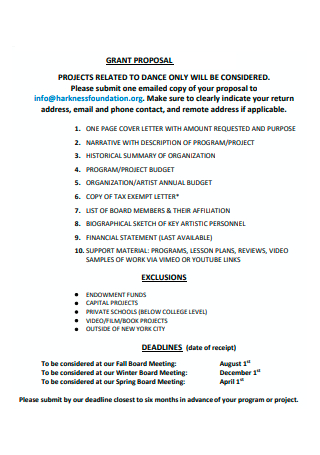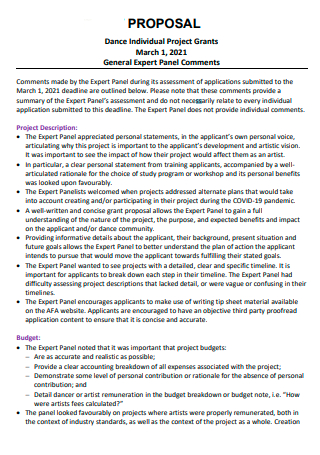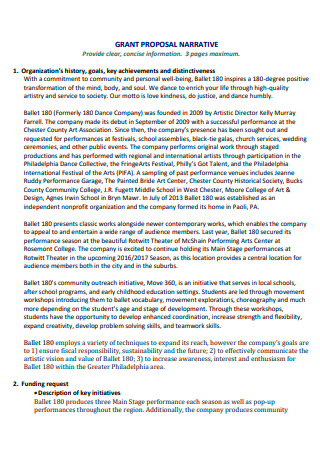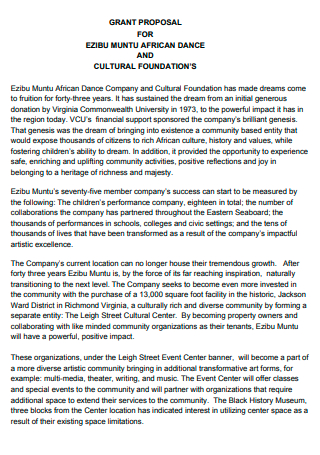3+ Sample Dance Grant Proposal
FREE Dance Grant Proposal s to Download
What Is a Dance Grant Proposal?
A dance grant proposal is a document which requests funding for a dance project, dancer, or choreographer. Not only funding, but also an explanation as to why there is such a need for grants. And how the grant will benefit the project or the individual. Professional dancers or choreographers in charge of a dance proposals and projects are examples of these professionals. The proposal’s goal is to persuade people to support a worthwhile cause.
Securing grant funding is already a significant deal for dance practitioners and organizations. They would have to meet the requirements and apply for the funding. And submitting a dance grant proposal could help. At danceusa.org, prospective dancers can learn more about their funding opportunities. It provides an excellent collection of funding sources and grants.
Types of Competitive Dance
The dance world is more like sports than anything else. There is fierce rivalry and very competitive spirits. Dancers, like musicians, must spend entire days studying how to perform a piece correctly. In today’s sports and society, there are numerous styles of dancing. Some are buried as part of the culture, while others flourish in public venues such as the Olympics. That’s like attending an art event and watching some creative artistry. Dances aren’t all that dissimilar whether it is performed in a club event or wedding event. And when it comes to competitions, there are a plethora of them to choose from.
Dance sports: There are numerous forms of dance sports available today. From tango and waltz to quickstep and rumba, there’s something for everyone. These styles are frequently classified as International Standard and International Latin. Dance sports are, as the name implies, a blend of dance and sports. In essence, couples are congregated on the dance floor and judged against one another. These professionals practice doing difficult and rapid dance maneuvers while remaining aware of their surroundings. Especially at the group stage, where players must stick out from the crowd. A competitive ballroom dancing demands a dance sport. The ages of those who can compete in this sport vary. There are various tiers in which they must compete too. Other dance forms include foxtrot, quickstep, paso doble, and jive. When it comes to choreography and execution, this sport has a lot of physical demands. A dancesport performance can also be included in a music video! Tap Dance: Tap is a type of dance that utilizes the sounds of shoes striking the floor. It creates its own music in this manner. However, rhythm is heavily involved. This type of dance necessitates precision and ability. Although it may appear to be simple, it requires a great deal of practice and training, just like any other dance. There are two main types of taps. The first is rhythm, while the second is Broadway tap. Broadway tap is more focused on dance and is generally seen in musicals and theaters. While rhythm tap claims itself to be a subset of jazz, which is primarily concerned with musicality. The heel and toe of the shoes generate the sound of a tap dance. There is a type of rhythm tap known as a “soft shoe” that may be used for sliding and can make music merely by tapping the shoes on the floor. It also has a beat and choreography, just like any other dance. Musical Theater: Musicals frequently include both dancing and singing. And it usually tells a tale or at the very least shows a progression. There will also be spoken dialogues and performances. The story is told through dramatic singing and acting. The movements and music, as well as some technical features, are used to communicate the themes. Lighting and props are examples of technical elements. All of them are excellent sources for establishing the tone and concept of the musical. Actors in musical theatre must hone their speech, singing ability, and dance moves. And they are always required to perform in front of an audience. It’s a dramatization of an existing story based on novels, television shows, or even history. Book musicals are a popular form of musical. It is made up of three parts: music, lyrics, and a book. Musicals can also be a part of the music business. Broadway is the most popular area for musicals. Musicals can also use actors who can sing. It necessitates acting abilities in addition to singing and dancing skills. Ballet: Ballet is a type of performance dance that is distinguished by its fundamental skills. In the eyes of the audience, it is both delicate and smooth. Ballets use both music and choreography into the dance. And there are numerous styles and varieties to consider. Ballet is performed in a variety of styles, including classical, neoclassical, romantic, and contemporary ballet. The distinction is found in techniques and movements. There are stories in romantic ballets around which the entire dance revolves. Neoclassical ballets, on the other hand, are frequently abstract, with no defined plot or costumes. Most of the contemporary ballet is performed barefoot. Where orchestral music is frequently played in the background. Contemporary ballet is also closely related to contemporary dances, which we will cover further later. Contemporary Dance: Many elements of other dances are included into contemporary dances. Dance improv and interpretative dance are two of the techniques. It is expressive and frequently tells a story. Even if it is still an abstract one. One of the most significant differences between contemporary dancing and other dances is how it can be used as a backdrop. How it may be a part of another piece while yet conveying the same thing in different ways. For instance, a vocalist may sing as modern dancers perform in the background.
Health Benefits of Dancing
Dancing, in the form of movements and routines, is a form of exercise and workout. Understanding the beats and rhythms may be simple but incorporating movement may be difficult. In other words, performing at private event and other occasions necessitates commitment and competence. Not only to avoid embarrassment, but also because you have presented yourself solely through your movements. Dancing, like sounds, can be a cacophony before it becomes melody. Without rhythms and skill, movements do not equal dancing. However, learning to dance is beneficial to your health. If you know how to pace yourself without overdoing it. And here is why.
Better Coordination and Flexibility: We sometimes struggle to coordinate what our minds want our bodies to perform. Dancing can help with this. Our bodies may become accustomed to dancing to a beat or just moving without falling over our own feet. Some people are simply gifted with good motor coordination. However, the majority of people suffer with it as well. And one method to help them improve is to teach them how to dance properly. Dancing has its own technique that necessitates the precision that comes with practice. As a result, people gradually learn to dance to the rhythm or move their bodies in accordance with it. Cardiovascular Improvement: Dance is also a form of exercise. As a result, it improves our lungs and heart. It not only strengthens the muscles, but it also actively aids in the circulation of blood throughout our bodies. Being active promotes cardiovascular health and strengthens the heart and lungs. Constant dancing can also help you increase stamina. It’s like a workout in that it aids in the circulation of blood to cardiovascular muscles. Which transports oxygen and nutrients throughout our bodies. Helps With Self-Confidence: Artists frequently gain confidence via their artistry and art. Being self-assured in one’s artwork also contributes to a great relationship with oneself. And dancers frequently acquire confidence while dancing. They are constantly watched not only during dancing lessons, but also throughout performances. As a result, they are constantly under pressure to perform well. Or to be able to perform sophisticated movements. It’s captivating and innovative as an audience. However, as dancers, it is the conclusion of their efforts. That is why a dance grant could help them achieve their goals on a larger scale. It provides them with the opportunity to pursue and play on the world’s most prestigious stages in front of a live audience. Being acknowledged and recognized for their work and abilities is what makes every artist or dancer happy. All the while, they are increasing their self-esteem. Improves Balance and Spatial Awareness: Balance allows us to avoid easily falling and injuring ourselves. And spatial awareness enables us to be acutely aware of our surroundings and the people in them. Perhaps it aids us in navigating the stream of traffic in our daily lives. It keeps us from colliding with someone and falling. It also aids in the prevention of knee and ankle injuries, which might impede our regular activities. Dancing also helps to strengthen our muscles and core, which aids with our balance. Balance is just as vital as speed for runners. It is not as simple as many believe to be able to run without falling. It is also necessary to maintain equilibrium to exert maximum strength and speed. And spatial awareness aids us in determining distances and simply being aware of our surroundings. Which could come in handy during social functions where we need to navigate while maintaining our personal space. Gain a New Skill: Dancing is a skill that can be useful in a variety of situations. It can become a highlight of an artist’s marketing plan. Dancing can also be used to impress someone if you simply wish to impress them. Of course, it is most effective in social situations. Furthermore, learning to dance has a positive impact on your life in general. It is beneficial to learn how to improve your agility and balance. Perhaps the exercise provided by dancing helps cardiovascular functions. And these abilities can be put to use in a competitive or entertaining performance. You can amaze your coworkers by dancing or performing at a workplace function.
Steps on How to Write a Dance Grant Proposal
Dancing is not a particularly lucrative profession. Athletes, musicians, and artists are all in the same boat. Results are critical in order to secure sponsorships to pay for trainings and other expenses. Although most people pursue dancing as a passion and a hobby, they also required financial assistance. How else can the beauty of dancing be spread? As a result, creating a dance grant proposal pdf is a viable option.
-
1.Introduce Your Organization
When it comes to grants, there is always an entity that is a giver or at least a middleman for donors. They would handle dancers’ and choreographers’ approvals and requests. It is then up to them to decide how to allocate the resources and how many people to fund. It is also up to them to attract additional funding from investors. As a result, the opening section of each grant submission should introduce the organization. This section can be used to highlight any important works or contributions. Most importantly, a brief description and introduction to the organization.
-
2. State the Objectives and Purpose
The objectives and goals of the organization are stated as part of the proposal. And it was for this reason that they devised the idea. Identifying who it benefits, for example. And why they must be supported and sponsored. Or how it could be used for good and helpful causes. Grants are usually granted to people who have a lot of potential in their area but don’t have a lot of money. As a result, the grant’s objective is to benefit those who can profit from it. Furthermore, the organization’s ultimate aims and goals must have some meaning.
-
3. Funding Sources
Of course, a consistent funding source is required for a grant to be self-sustaining. Grants can be given only once, therefore the funding do not have to be constant. A tour, on the other hand, necessitates ongoing financial support for dance projects. That must imply that there is a willing grant sponsor who will continue to contribute. It is also critical to underline the importance of a consistent financing source for continuous operation. And, if the goal is long-term, this proposition must be as persuasive as feasible. Donors must understand why their money is vital, as well as who will get it and how it will be used.
-
4. Guidelines
There are criteria for who can receive a grant based on their qualifications. Guidelines for choreographers and dancers, for example, would be included in a dance grant proposal. It could also be a list of qualifications that potential grantees must meet. And, because grants can only cover a limited number of people, the requirements are much more critical. It also provides everyone with an equal fighting chance and equal ground to apply. There are approval guidelines or even know how to apply for a simple procedure.
-
5. Project Design
Methods and strategies are used in project design to fulfill the proposal’s aims and objectives. For example, describing the services that the funding will also provide. Alternatively, clarify what success involves. This would help your possible sponsor to assess the merit of your grant proposal pdf.
FAQS
Is a Dance Grant Proposal Beneficial?
A dance grant proposal aids in persuading sponsors of the grant’s goal and benefits. It enables a more detailed project design and the establishment of guidelines. It also makes it easier to encourage sponsors to support a specific group. Simply by presenting reviewers with a comprehensive and on-point proposal.
What Are Other Types of Grants?
Federal grants also come in the form of competitive grants, formula grants, continuation or renewal grants, and pass-through grants.
How Does Grants Help?
Grants enable people who are struggling financially to have the opportunity to thrive without having to worry about money. Many people are given fewer opportunities because they are poor or simply do not have enough money. It is especially true for artists and athletes. Training and coaching rates are exorbitant. It’s difficult to compete without a sponsor or a subsidy.
Some dance projects or dance professionals require funding to continue their work. They require financial assistance in to continue training or performing. Using the sample dance grant proposal above is one technique to attract a donor! Make certain that you use the best dance grant proposal templates!




